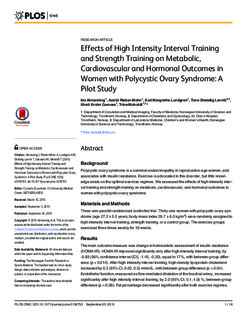Effects of High Intensity Interval Training and Strenght Training on Metabolic, Cardiovascular and Hormonal Outcomes in Women with Polycystic Ovary Syndrome: A Pilot Study
Almenning, Ida; Rieber-Mohn, Astrid; Lundgren, Kari Margrethe; Løvvik, Tone Shetelig; Garnæs, Kirsti Krohn; Moholdt, Trine Tegdan
Journal article, Peer reviewed
Permanent lenke
http://hdl.handle.net/11250/2372881Utgivelsesdato
2015Metadata
Vis full innførselSamlinger
Sammendrag
Background:
Polycystic ovary syndrome is a common endocrinopathy in reproductive-age women, and associates with insulin resistance. Exercise is advocated in this disorder, but little knowledge exists on the optimal exercise regimes. We assessed the effects of high intensity interval training and strength training on metabolic, cardiovascular, and hormonal outcomes in women with polycystic ovary syndrome.
Materials and Methods:
Three-arm parallel randomized controlled trial. Thirty-one women with polycystic ovary syndrome (age 27.2 ± 5.5 years; body mass index 26.7 ± 6.0 kg/m2) were randomly assigned to high intensity interval training, strength training, or a control group. The exercise groups exercised three times weekly for 10 weeks.
Results:
The main outcome measure was change in homeostatic assessment of insulin resistance (HOMA-IR). HOMA-IR improved significantly only after high intensity interval training, by -0.83 (95% confidence interval [CI], -1.45, -0.20), equal to 17%, with between-group difference (p = 0.014). After high intensity interval training, high-density lipoprotein cholesterol increased by 0.2 (95% CI, 0.02, 0.5) mmol/L, with between group difference (p = 0.04). Endothelial function, measured as flow-mediated dilatation of the brachial artery, increased significantly after high intensity interval training, by 2.0 (95% CI, 0.1, 4.0) %, between-group difference (p = 0.08). Fat percentage decreased significantly after both exercise regimes, without changes in body weight. After strength training, anti-Müllarian hormone was significantly reduced, by -14.8 (95% CI, -21.2, -8.4) pmol/L, between-group difference (p = 0.04). There were no significant changes in high-sensitivity C-reactive protein, adiponectin or leptin in any group.
Conclusions:
High intensity interval training for ten weeks improved insulin resistance, without weight loss, in women with polycystic ovary syndrome. Body composition improved significantly after both strength training and high intensity interval training. This pilot study indicates that exercise training can improve the cardiometabolic profile in polycystic ovary syndrome in the absence of weight loss.
